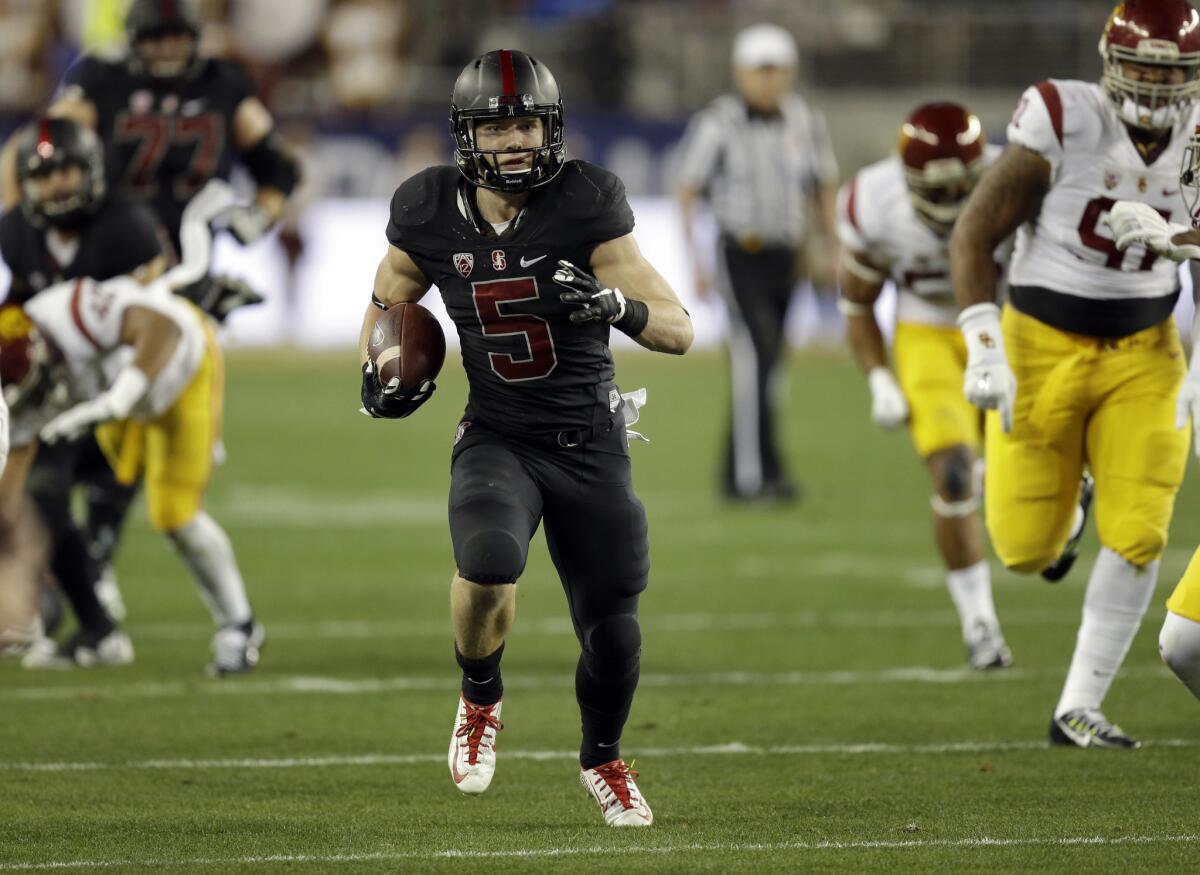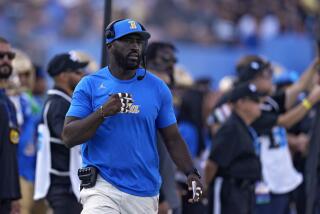The Iowa-Stanford Rose Bowl matchup is pretty good for a couple of also-rans

Stanford running back Christian McCaffrey (5) rushes against USC in the Pac-12 Conference championship.
They’re the first and second runners-up in college football’s bowl-game beauty pageant, teams with great looks and personality that came within a two-point conversion and a fourth-down stop of playing for a national championship.
Fifth-ranked Iowa and sixth-ranked Stanford will meet in the 102nd Rose Bowl on Friday, one day after Oklahoma plays Clemson and Michigan State plays Alabama in the College Football Playoff semifinals Thursday night.
The timing of the traditional New Year’s Day game could give Iowa-Stanford the feel of a consolation-bracket game, the look of a plate of leftovers after a New Year’s Eve feast. The participants aren’t buying it.
“Winning the Pac-12 title and going to the Rose Bowl is not something to frown about,” Stanford senior linebacker Blake Martinez said Sunday. “Obviously, a lot of us were hoping to make it to the College Football Playoff, but you can’t beat this. It’s going to be a fun show.”
The holiday trip to Pasadena is becoming an annual pilgrimage for Stanford, which will make its third Rose Bowl appearance in four years. The Cardinal beat Wisconsin, 20-14, after the 2012 season and lost to Michigan State, 24-20, after 2013.
For Iowa, it’s a once-in-a-generation trip. The Hawkeyes haven’t played in the Rose Bowl since Jan. 1, 1991. They haven’t won one since Jan. 1, 1959, when current Coach Kirk Ferentz, now 60, was 3 years old.
“This is an incredible opportunity to play the No. 6 team in the nation, a conference champion,” said Iowa receiver Matt VandeBerg, who has a team-leading 61 receptions for 639 yards. “We can’t ask for more of a unique challenge than to be the first Iowa team to come here in a long time.”
Iowa has played football since 1889 and Stanford since 1892, but this is the first meeting between the teams. With both featuring run-oriented offenses and big, physical front lines, it shouldn’t take long.
“It’s going to be smash-mouth football,” Stanford defensive end Aziz Shittu said. “The game is scheduled for 3 1/2 hours. It’s probably going to end in three hours the way both teams are going to run the ball.”
The headliner atop the Rose Bowl marquee is Stanford sophomore Christian McCaffrey, the Heisman Trophy runner-up who ran for 1,847 yards and eight touchdowns, caught a team-high 41 passes for 540 yards and four scores, averaged 38.9 yards per kickoff return and threw two touchdown passes.
Gifted with the burst, vision and elusiveness of former USC star Reggie Bush, McCaffrey set an NCAA record with 3,496 all-purpose yards.
But he is not the sole weapon in an offense that ranked 19th nationally in scoring (37.2 points per game) and 39th in total yards (436 a game).
Senior quarterback Kevin Hogan completed 194 of 283 passes for 2,644 yards, with 24 touchdowns and seven interceptions, and he has a fleet of talented targets in Michael Rector, Austin Hooper and Devon Cajuste.
The Cardinal, despite a season-opening loss at Northwestern, appeared poised for a Final Four run before a heartbreaking 38-36 loss to Oregon on Nov. 14, when Hogan’s two-point conversion pass fell incomplete with 10 seconds left.
But Stanford rebounded with a 35-22 win over California and a thrilling 38-36 win over then-sixth-ranked Notre Dame, in which Hogan drove the Cardinal 45 yards in the final 30 seconds and Conrad Ukropina kicked a 45-yard field goal as time expired.
Stanford was locked in a Pac-12 championship-game nail-biter with USC, clinging to a 20-16 lead late in the third quarter when a blitzing Martinez blindsided quarterback Cody Kessler, forcing a fumble that Solomon Thomas returned 34 yards for a touchdown. The Cardinal won, 41-22.
The Hawkeyes’ path to Pasadena wasn’t as perilous. They didn’t have to play traditional Big Ten powers Ohio State and Michigan, and they beat only two ranked teams, No. 19 Wisconsin (10-6 on Oct. 3) and No. 20 Northwestern (40-10 on Oct. 17), en route to their first undefeated regular season (12-0) since 1922. A 27-24 win over Pittsburgh on Sept. 19 came on Marshall Koehn’s 57-yard field goal as time expired.
Iowa was ranked fourth entering the Big Ten championship game against fifth-ranked Michigan State, and the Hawkeyes took a 13-9 lead early in the fourth quarter when quarterback C.J. Beathard connected with Tevaun Smith on an 85-yard touchdown pass play.
But the Spartans mounted a 22-play, 82-yard, nine-minute drive, converting five third-down plays and one fourth-down play, and scored with 27 seconds left for a 16-13 win and a berth in Thursday’s national semifinals.
Iowa’s offense doesn’t so much dazzle as wear down opponents with its stout line, a trio of strong runners — Jordan Canzeri, LeShun Daniels Jr. and Akrum Wadley — and a quarterback known for consistency and clutch play. The Hawkeyes rank 40th nationally in rushing (192 yards a game) and 47th in scoring (32.1).
Iowa is tied for eighth nationally (with USC) with a plus-12 turnover margin and has scored 86 points off turnovers. The Hawkeyes have yielded 114.9 yards rushing a game, 11th best in the country, and they led the Big Ten with 18 interceptions.
If Iowa feels any lingering disappointment in narrowly missing the Final Four, it will probably melt when the team buses wind their way through the Arroyo Seco on Friday.
“You come through this little neighborhood and you’re thinking there is no way there could be a big stadium out here,” said Iowa offensive coordinator Greg Davis, the former Texas assistant coach who helped the Longhorns defeat USC, 41-38, in the memorable 2006 Rose Bowl.
“Then you come over this little knoll and you look down to a massive sea of humanity. It’s almost like a state-fair mentality, and the mountains are in the background, and then you realize, ‘OK, this is why they call it The Granddaddy of Them All.’ It’s really a tremendous environment.”
Twitter: @MikeDiGiovanna
More to Read
Go beyond the scoreboard
Get the latest on L.A.'s teams in the daily Sports Report newsletter.
You may occasionally receive promotional content from the Los Angeles Times.











